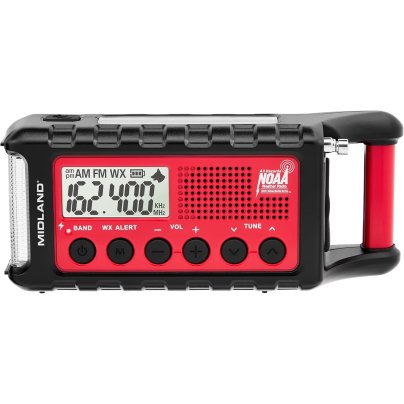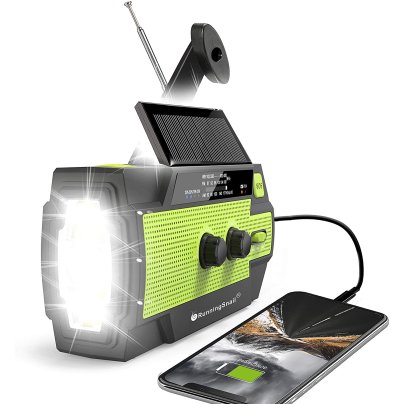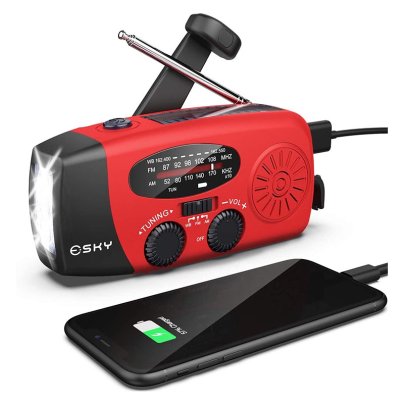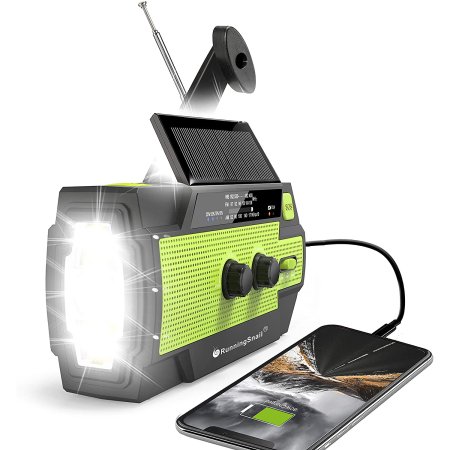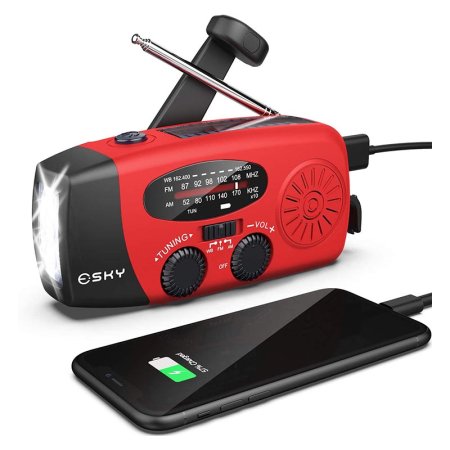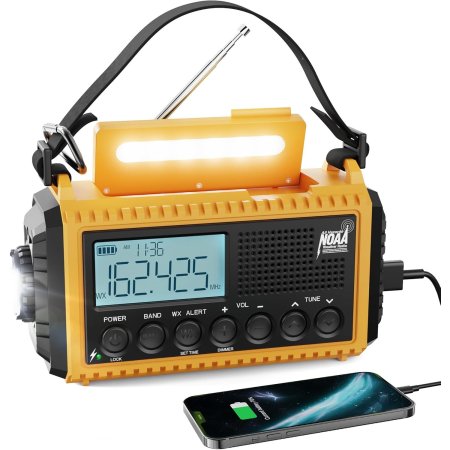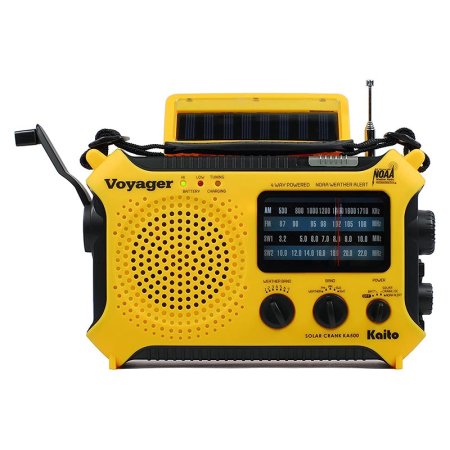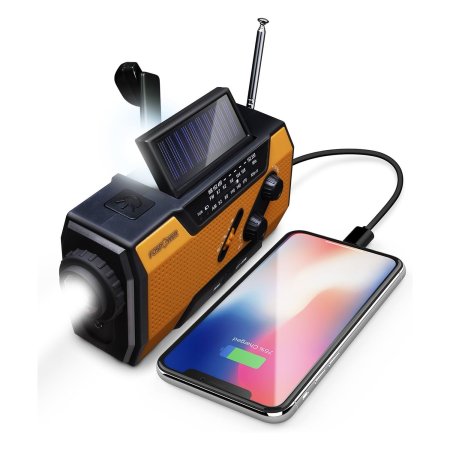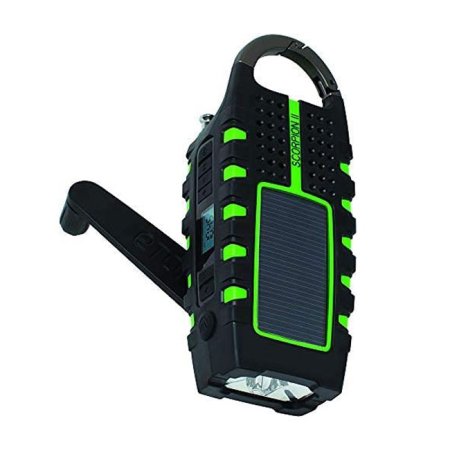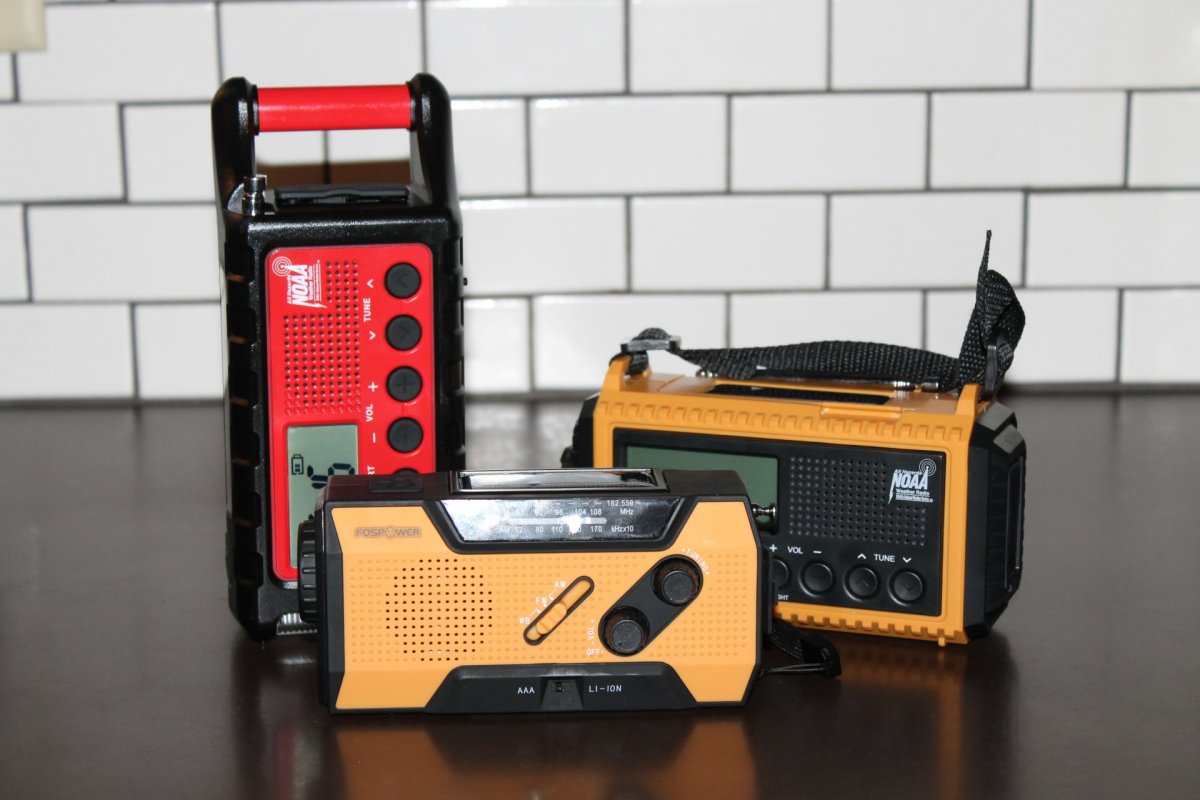
We may earn revenue from the products available on this page and participate in affiliate programs. Learn More ›
Weather-related emergencies are often unpredictable, so stocking an emergency kit with a hand-crank radio is a great way to ensure you’re tapped into the outside world. Today’s models have built-in extras and features—from flashlights and built-in batteries to phone-charging ports and solar-powered options—that maximize the chances of staying safe. We spent 3 days field-testing seven different hand-crank radios to determine which features matter most and which boost overall functionality during an extended power outage.
After extensive testing and careful consideration, our top pick is the Midland ER310 Emergency Hand-Crank Radio. It has excellent AM, FM, and NOAA reception, an easy-to-read digital display, phone charging ports, a powerful flashlight, and a long-lasting battery. Other models also performed well, earning a spot on our list.
Read on to learn more about the shopping priorities we recommend to increase home safety during weather events, as well as to learn how each of the best hand-crank radios performed in our tests.
- BEST OVERALL: Midland Portable ER310 Emergency Hand-Crank Radio
↓ Jump to Review - RUNNER-UP: DaringSnail MD090P Emergency Weather Hand-Crank Radio
↓ Jump to Review - BEST BANG FOR THE BUCK: Esky Portable Emergency Weather Hand-Crank Radio
↓ Jump to Review - BEST DIGITAL TUNING: Raynic CR1009Pro Solar/Hand-Crank Emergency Radio
↓ Jump to Review - BEST SHORTWAVE: Kaito KA500 AM FM Shortwave Solar Hand-Crank Radio
↓ Jump to Review - BEST COMPACT: FosPower A1 Emergency Solar Hand-Crank Radio
↓ Jump to Review - BEST WEATHERPROOF: Eton Scorpion II Hand-Crank Radio & Flashlight
↓ Jump to Review
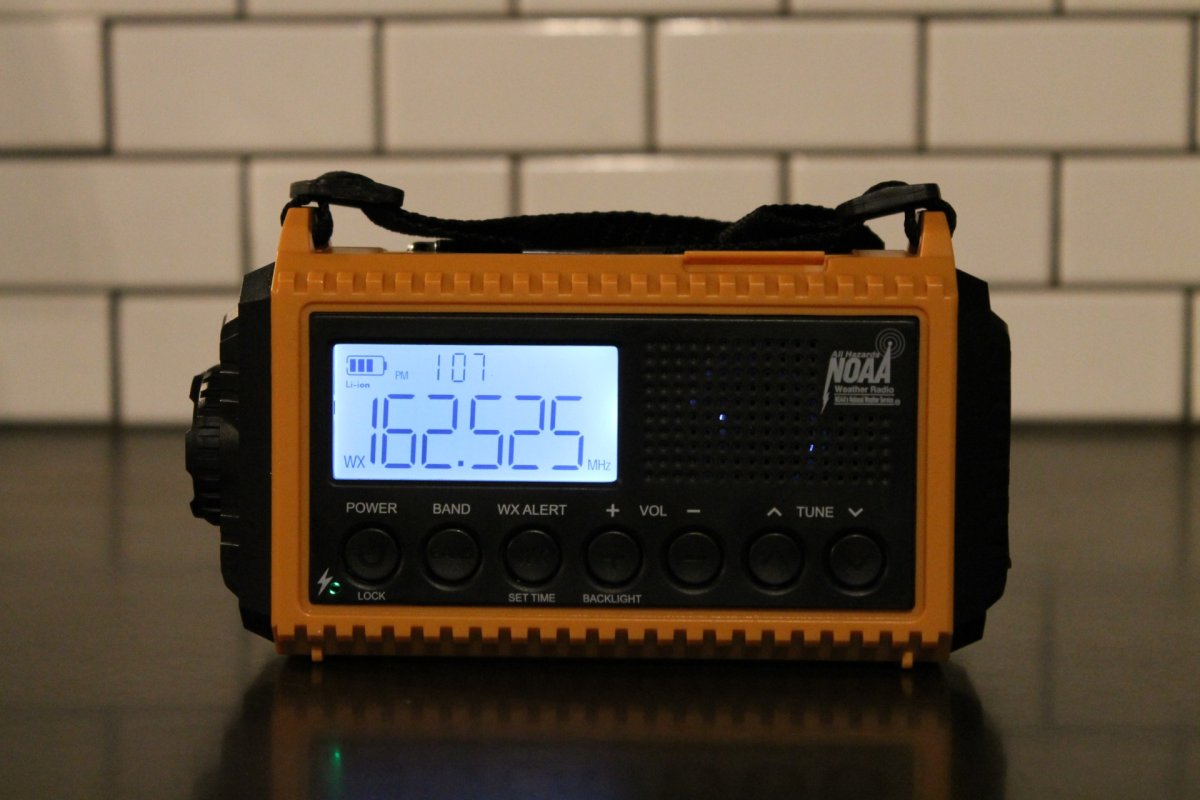
Hand-Crank Radios Comparison Chart
| Power | Frequencies | Size | Weight | |
| Midland ER310 Emergency Hand-Crank Radio | 2,600mAh rechargeable battery (Li-ion) | AM, FM, and NOAA | 8 inches long by 3.4 inches high by 2.4 inches wide | 1.46 pounds |
| DaringSnail MD090P Emergency Weather Hand-Crank Radio | 4,000mAh rechargeable battery (Li-ion) | AM, FM, and NOAA | 6.2 inches long by 3.2 inches high by 2.5 inches deep | 13.9 ounces |
| Esky Portable Emergency Weather Hand-Crank Radio | 2,000mAh rechargeable battery (Li-ion) | AM, FM, and NOAA | 5.3 inches long by 2.5 inches high by 2 inches deep | 7.45 ounces |
| Raynic CR1009Pro Solar/Hand-Crank Emergency Radio | 5,000mAh rechargeable battery (Li-ion) | AM, FM, NOAA, and SW | 6.8 inches long by 3.7 inches high by 2.9 inches deep | 1.2 pounds |
| Kaito KA500 AM FM Shortwave Solar Hand-Crank Radio | 600mAh rechargeable battery (NiMH) | AM, FM, NOAA, SW1, and SW2 | 11.1 inches long by 5.8 inches high by 3.3 inches deep | 1.8 pounds |
| FosPower A1 Emergency Weather Radio | 2,000mAh rechargeable battery (Li-ion) | AM, FM, and NOAA | 6.2 inches long by 2.9 inches high by 2.1 inches deep | 0.68 pounds |
| Eton Scorpion II Hand-Crank Radio & Flashlight | 800mAh rechargeable battery (Li-ion) | AM, FM, and NOAA | 6.5 inches long by 2.5 inches wide by 1.9 inches deep | 10.6 ounces |

Our Top Picks
Whether shoppers need a small radio to stow away with other emergency supplies or a larger option with longer battery life and built-in features, this guide can help. We tested seven different models, each of which excels in its own way. In our reviews ahead, find out how each hand-crank radio performed and why we consider these to be among the best hand-crank radios for use in emergencies.
Best Overall
Midland ER310 Portable Emergency Hand-Crank Radio
What We Like
- Easy to tune with clear sound
- Heavy-duty construction survived many drops in testing
- Battery lasts up to 32 hours
- Features a flashlight and phone-charging ports
What We Don’t Like
- Pricey compared to similar options
Specs
- Power 2,600 milliampere-hour (mAh) rechargeable battery (Li-ion)
- Frequencies AM, FM, and NOAA
- Size 8 inches long by 3.4 inches high by 2.4 inches wide
- Weight 1.46 pounds
Our Ratings: Functionality 4.8/5; Sound 5/5; Durability 5/5; Value 4.7/5
Hand-crank radios with long-lasting batteries and extra features like built-in phone charging ports and flashlights are some of the most handy for weather-related emergencies. With access to NOAA weather alerts and AM/FM radio, the Midland ER310 provides all this and more.
This hand-crank radio is rechargeable via the provided USB charger or through its hand-crank mechanism. Users can enjoy 9 minutes of battery life for every one minute of hand-cranking. The radio also has a solar panel to help to maintain its battery life. If that’s not enough, the unit can be run off of six AA batteries (not included). When the lithium-ion battery is fully charged, the radio can run for up to 32 hours.
We found using this hand-crank radio intuitive. Thanks to the clear digital display, switching between the NOAA weather alerts, AM, and FM channels was easy. The radio signal was loud and clear, even in our basement, where other radios produced static. This Midland E+Ready radio has a headphone jack plus a USB port for charging phones and tablets. It also features an ultrasonic dog whistle, a flashlight with two brightness levels, and an SOS strobe.
What our tester says: “The Midland ER310 hand-crank radio provided crystal clear audio, access to NOAA weather alerts and AM and FM radio channels. The built-in flashlight, multiple charging options, phone charging ports, and durable construction provided everything I could ask for in an emergency weather radio.” —Katie Barton, Product Reviews tester and writer
Get the Midland hand-crank radio at Amazon, Tractor Supply Co., Best Buy, or Cabela’s.
Runner-Up
DaringSnail MD090P Emergency Weather Hand-Crank Radio
What We Like
- Large 4,000mAh rechargeable battery
- Excellent AM, FM, and NOAA Weather Radio reception
- Easy-to-use analog display
- Compact and lightweight construction
- Motion-sensor light conserves battery in a power outage
What We Don’t Like
- No automated alert feature
- Stiff tuning knob
Specs
- Power 4,000mAh rechargeable battery (Li-ion)
- Frequencies AM, FM, and NOAA
- Size 6.2 inches long by 3.2 inches high by 2.5 inches deep
- Weight 13.9 ounces
Our Ratings: Functionality 4.3/5; Sound 5/5; Durability 4/5; Value 4.7/5
DaringSnail’s solar-powered hand-crank radio boasts the necessary features for responsible and streamlined emergency preparedness. This radio features a replaceable 4000mAh lithium-ion battery and three different methods for charging: a folding hand-crank, a USB charger, and a built-in solar panel.
This hand-crank radio offers AM and FM radio reception as well as seven NOAA weather stations for monitoring emergency weather conditions. A telescoping antenna helps maintain clear reception. The built-in flashlight offers three modes, including settings for far, dipped (pointing downward), and both beams at the same time. There is also a built-in reading lamp underneath the solar panel, allowing users to light up the room during power outages. Additionally, a motion sensor picks up movement and illuminates the lamp for 30 seconds.
In our opinion, this no-frills option offers one of the best combinations of features for emergencies (read our full review of the DaringSnail MD090P). In addition to its signal sensitivity, it offers the added benefit of storing enough electricity to boost a cell phone charge. It provided a 50 percent cell phone charge in a couple of hours, with enough left in the battery to power the radio for 10 hours straight at a low volume. The analog display with manual tuning and on/off/audio knobs were easy and intuitive to operate. But, because the tuner turned somewhat stiffly, precision tuning wasn’t easy. We picked up plenty of clear FM stations, but most of the AM stations came in with some amount of static.
What our tester says: “DaringSnail emergency radio offered excellent AM, FM, and National Oceanic and Atmospheric Administration (NOAA) Weather Radio reception with good sound quality. It also boasts a large-capacity battery that makes phone charging easy while leaving plenty of power for continued runtime. ”—Mark Wolfe, Product Reviews tester and writer.
Get the DaringSnail hand-crank radio at Amazon or DaringSnail.
Best Bang for the Buck
Esky Portable Emergency Weather Hand-Crank Radio
What We Like
- Pocket-size, lightweight emergency radio is easy to pack and carry
- Long-lasting battery life while operating
- Works as a portable phone charger or flashlight
What We Don’t Like
- Suitable for emergency charging only
- Limited functionality beyond radio, flashlight, and emergency charger
- Built-in lithium-ion battery has a 5-year life expectancy
Specs
- Power 2,000mAh rechargeable battery (Li-ion)
- Frequencies AM, FM, and NOAA
- Size 5.25 inches long by 2.5 inches high by 2 inches deep
- Weight 7.45 ounces
Our Ratings: Functionality 4/5; Sound 4/5; Durability 3.5/5; Value 4.3/5
For some folks, a small, inexpensive option that really works may be the best choice. Those shopping for a small, lightweight, and affordable unit may want to consider the Esky portable emergency weather radio. It measures 5.3 inches long by 2.5 inches high by 2 inches deep and weighs just 7.45 ounces, making it a good option for commuters. Although this little device doesn’t offer many extras, it picks up nearby AM, FM, and NOAA weather stations, and, having recently been upgraded, it now includes a 2,000mAh battery that can boost a cell phone for a quick emergency call if needed.
Although this radio is small and relatively spartan, it does include the emergency features we find most important. Standard and micro USB ports facilitate the charging of other devices and AC charging of the onboard battery. The battery can also be charged with the hand crank or via the small solar panel. The three-LED flashlight offers basic on/off functionality. A telescoping antenna helps ensure the best possible reception of FM and NOAA signals, while an internal antenna receives AM frequencies.
The only problem with the unit’s small size was that the analog display was not easy to read or super accurate when it came to finding a known frequency/station. When we were close to the known station, we sometimes had to slow down and move the dial back and forth a few times to zero in on it.
Get the Esky hand-crank radio at Amazon or Walmart.
Best Digital Tuning
Raynic CR1009Pro Solar/Hand-Crank Emergency Radio
What We Like
- Offers many useful features for the price
- Easy-to-use hand crank
- Auto alert and auto-scan features
- Built-in flashlight, reading light, and charging ports
What We Don’t Like
- Less durable than some higher-priced options
- A little bit of static on NOAA frequencies
Specs
- Power 5,000mAh rechargeable battery (Li-ion)
- Frequencies AM, FM, NOAA, and SW
- Size 6.8 inches long by 3.7 inches high by 2.9 inches deep
- Weight 1.2 pounds
Our Ratings: Functionality 4.5/5; Sound 4/5; Durability 4/5; Value 4.7/5
The Raynic hand-crank emergency radio packs in a lot of valuable features at an attractive price point. It features four frequencies: NOAA weather alerts, FM, AM, and shortwave, with an easy-to-use tuner and clear digital display. We were able to pick up various radio channels, and the sound was loud enough for daily or emergency related uses and was mostly clear except for a bit of static on the NOAA frequencies.
This hand-crank radio can be charged via the included AC adapter, USB charger, solar panel, or through its hand-crank mechanism. Its advertised run-time is 12 hours of radio time or 18 hours of flashlight time, but it exceeded this during our testing, and the battery was still three-quarters full after letting the radio run for 24 hours straight.
This emergency weather radio has a built-in USB port for charging all devices and a headphone jack for private listening. Other useful features include a reading lamp, a flashlight, and an SOS alarm. It also has an optional emergency weather alert setting that can alert users to impending dangerous weather events when the device is powered on or in standby mode.
Get the Raynic hand-crank radio at Amazon.
Best Shortwave
Kaito KA500 AM FM Shortwave Solar Hand-Crank Radio
What We Like
- Features AM, FM, NOAA, and shortwave radio bands
- Multiple charging methods
- Also works with 3 AA alkaline batteries
- Preprogrammed NOAA radio frequencies
What We Don’t Like
- Smaller-than-average rechargeable battery offers less runtime per charge
Specs
- Power 600mAh rechargeable battery (NiMH)
- Frequencies AM, FM, NOAA, SW1, and SW2
- Size 11.1 inches long by 5.8 inches high by 3.3 inches deep
- Weight 1.8 pounds
Our Ratings: Functionality 4/5; Sound 5/5; Durability 4/5; Value 4/5
Those who want more functionality and a broader range of reception may be considering a shortwave radio option. Shortwave radio frequencies are transmitted over much longer distances of hundreds (or even thousands) of miles, and are often used by international broadcasters and audiences. The Kaito KA500 is a good emergency radio that offers the AM, FM, and NOAA Weather Radio bands that are locally important during power outages and emergency situations, as well as two shortwave radio bands: SW1, which is 3.2 to 8.0 megahertz, and SW2, which is 9.0 to 22.0 megahertz, for curious listeners.
The radio features a large analog display, a telescoping antenna, and manual control knobs for AM/FM/SW1/SW2 tuning, volume, off/power mode, band selection, and weather band tuning. It comes equipped with a built-in 600mAh nickel-metal hydride (NiMH) rechargeable battery that may be charged by AC adapter, USB PC connection, hand crank, or via the built-in solar panel. Users also have the option to install three AA alkaline batteries to power the radio. The three-way light switch features a LED flashlight with display backlight, red flashing SOS, and five LED reading lamp modes.
In many circumstances, this may not be the best option for use as a primary cell phone battery backup. But because the hand crank can be used to charge a phone directly—instead of charging the radio battery first and then dump-charging the phone from the radio battery—it is a faster, more direct way to get emergency power into a phone.
Get the Kaito hand-crank radio at Amazon, Kaito Radios, or Walmart.
Best Compact
FosPower A1 Emergency Solar Hand-Crank Radio
What We Like
- Compact size is ideal for storage or road trips
- Features a flashlight, reading light, and SOS alarm
- 3 charging options
What We Don’t Like
- No digital display
- Potential durability issues
Specs
- Power 2,000mAh rechargeable battery (Li-ion)
- Frequencies AM, FM, and NOAA
- Size 6.2 inches long by 2.9 inches high by 2.1 inches deep
- Weight 0.68 pounds
Our Ratings: Functionality 4.5/5; Sound 4/5; Durability 3.5/5; Value 5/5
Those who are always on the go or appreciate a lightweight and compact model that’s easy to store in survival kits will like the FosPower A1 hand-crank emergency radio. It weighs less than 1 pound and measures under 7 inches long, but it still has all the features necessary to keep up to date on the latest weather forecasts.
This FosPower emergency weather radio features NOAA, AM, and FM frequencies. We were able to pick up many AM and FM stations clearly. However, when we tried to tune into NOAA weather alerts from our basement (admittedly, a spot with less-than-stellar reception, but also where one might take refuge in a storm), we picked up a lot of background static. We were still able to hear all of the alerts, just not with the clarity some of the other radios provided.
The FosPower hand-crank radio and flashlight can be charged via a USB port, hand-crank, or solar power. It can also be powered by three AAA batteries during emergencies. It features charging ports for powering phones, an SOS alarm, a reading light, and a flashlight. Since weather-related radios need to be durable in emergency situations, we dropped all models from 5 feet high onto a hard surface three times. Unfortunately, during our durability tests, a plastic piece broke off of this model’s flashlight, but everything (including the flashlight) still worked just fine.
Get the FosPower hand-crank radio at Amazon or Walmart.
Best Weatherproof
Eton Scorpion II Hand-Crank Radio & Flashlight
What We Like
- Faster scanning with digital tuning
- Certified IPX4 splash-proof
- Compact size and lightweight construction
- Includes a built-in carabiner and bottle opener
What We Don’t Like
- Best reception within 50 miles of the broadcast tower
- Limited battery size
Specs
- Power 800mAh rechargeable battery (Li-ion)
- Frequencies AM, FM, and NOAA
- Size 6.5 inches long by 2.5 inches wide by 1.9 inches deep
- Weight 10.6 ounces
Our Ratings: Functionality 4.3/5; Sound 4/5; Durability 5/5; Value 4/5
For off-grid adventures, an emergency radio must meet multiple preparedness needs. The Eton Scorpion II, with its rugged construction and splash-proof certification, does exactly that, ensuring safe, reliable outdoor operation in any weather. This AM, FM, and NOAA Weather Radio features a digital tuner with an LCD clock display, telescoping antenna, LED flashlight, and emergency siren.
The rubber exterior skin provides slip resistance for wet hands and shock protection in case of accidental drops. A carabiner and bottle opener are built into the exterior of the radio housing for added versatility. The 800mAh lithium-ion battery can be charged with the included mini USB cable, the hand crank, or the built-in solar panel. A USB-out port supports cell phone charging from the battery.
We were impressed right away by the sturdy construction of the Eton Scorpion II. The compact, stocky build and rugged housing felt more durable and ready for outdoor use than any of the other models we tested. This radio has an Ingress Protection (IPX) rating for splash resistance: IPX4 means it is safe for operating in rainy weather but should not be submerged in water.
The smaller-than-average battery (800mAh) provided 13 hours of continuous radio play. Charging the depleted battery for 1 minute with the hand crank added about 5 minutes of radio time. Like the other small-battery radios we tested, this one should only be relied upon for a minimal cell phone boost—not for a significant recharge.
Get the Eton hand-crank radio at Amazon, The Home Depot, Lowe’s, Bass Pro Shops, or Walmart.
Jump to Our Top Picks
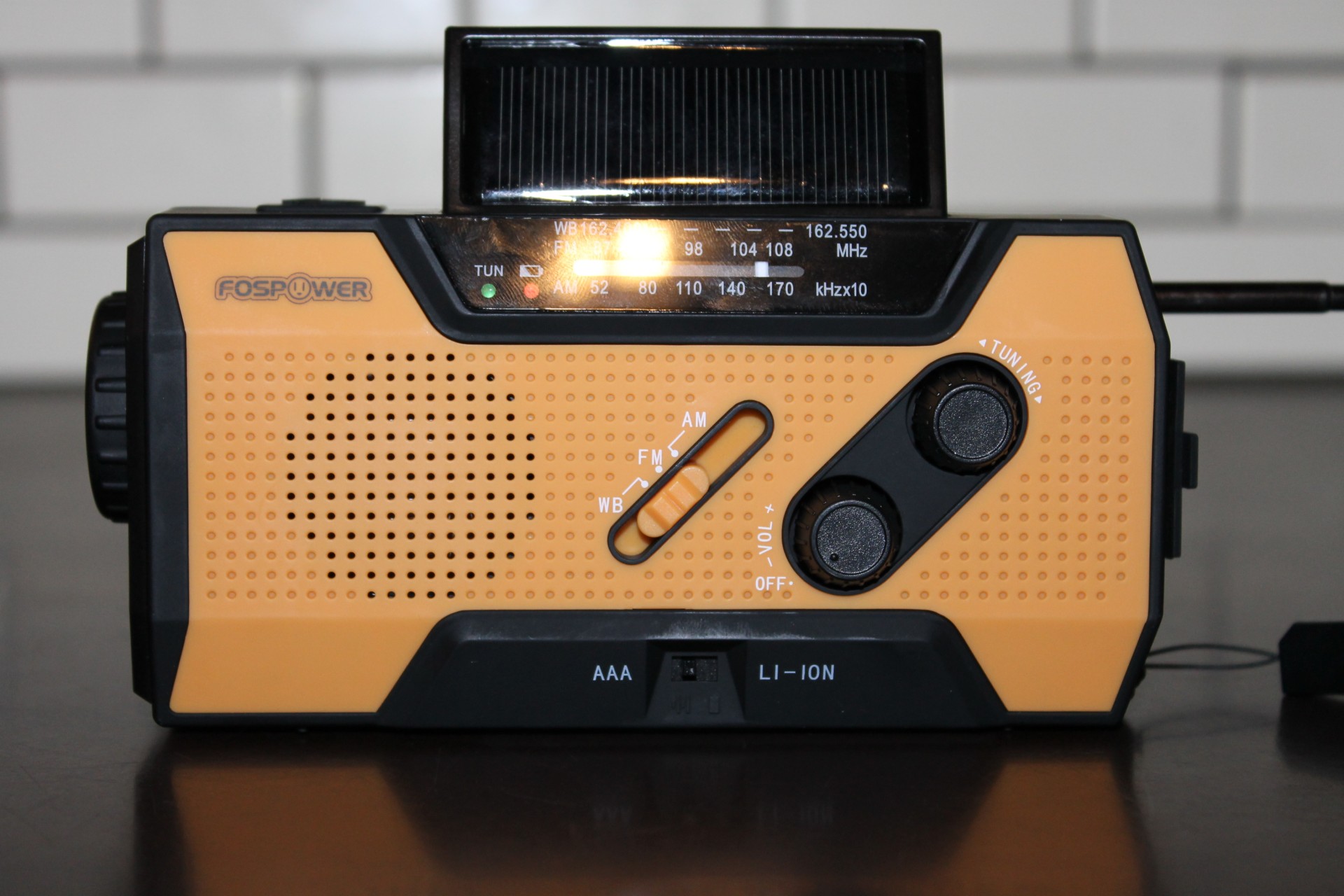
How We Tested the Best Hand-Crank Radios
| Products tested | 10 |
| Time spent testing | 3 days |
| Tests performed | 6 |
| Price range | $20 to $70 |
We set up testing scenarios to simulate the types of real-world events that hand-crank radios are designed to meet, such as severe storms and power outages. In order to get a real feel for how each model would perform, we created a scoring rubric that included battery life, charging capabilities, radio signal reception, audio quality, portability, and additional features that might make sheltering in place a little easier.
We started by recording the physical dimensions and weight of each radio and charging the batteries. Next, we counted the number of AM, FM, and National Oceanic and Atmospheric Administration (NOAA) stations that each radio received in three different locations and awarded 1 to 5 points for signal reception. We also scored the radios on a 1 to 5 scale according to overall sound quality. We evaluated each radio’s construction, dropping each one three times onto a hard surface to test for durability. Finally, we awarded additional points for such bonus features as charging ports for other devices, clocks, flashlights, and battery efficiency observed by a runtime test.
| Functionality | Sound | Durability | Value | |
| Midland ER310 Portable Emergency Hand-Crank Radio | 4.8/5 | 5/5 | 5/5 | 4.7/5 |
| DaringSnail MD090P Emergency Weather Hand-Crank Radio | 4.3/5 | 5/5 | 4/5 | 4.7/5 |
| Esky Portable Emergency Weather Hand-Crank Radio | 4/5 | 4/5 | 3.5/5 | 4.3/5 |
| Raynic CR1009Pro Solar/Hand-Crank Emergency Radio | 4.5/5 | 4/5 | 4/5 | 4.7/5 |
| Kaito KA500 AM FM Shortwave Solar Hand-Crank Radio | 4/5 | 5/5 | 4/5 | 4/5 |
| FosPower A1 Emergency Solar Hand-Crank Radio | 4.5/5 | 4/5 | 3.5/5 | 5/5 |
| Eton Scorpion II Hand-Crank Radio & Flashlight | 4.3/5 | 4/5 | 5/5 | 4/5 |
What to Consider When Choosing a Hand-Crank Radio

Hand-crank radios might seem old school, but the newer products on the market feature modern technology that makes them worth adding to a kit of emergency essentials. Read on to discover several of the most important considerations to keep in mind while shopping for the best hand-crank radio, from supported frequencies and weatherproof qualities to portability and more.
Power
Today’s hand-crank radios are all about usable power. In fact, many of the best hand-crank radios can charge or run using several power-source options, such as accepting replaceable batteries and featuring onboard batteries that charge via a solar panel or a USB port. Most of these devices can also charge cell phones or flashlights in a pinch.
When it comes to battery size, there are options as compact as 600mAh batteries, which are ideal for packing in a bag or stowing in a glove box, and larger 4,000mAh batteries for longer charging and flashlight usability. Some larger batteries offer more than 20 hours of radio time or 15 hours of flashlight power. While they might take 10 to 15 minutes of cranking for a usable charge, users can replenish the battery and charge devices even when the power is out.
Supported Frequencies
While weather-related frequencies should be the main focus of emergency hand-crank radios, entertainment can go a long way toward maintaining morale when the power is out. A high-quality hand-crank radio should be easy to swap between several frequencies.
NOAA Weather Radio-enabled emergency radios are capable of AM, FM, and weather-band frequencies from the National Weather Service. Music, talk shows, sports reports, and more are available on AM/FM frequencies. FM radio waves don’t travel as far, and as such, these local radio stations provide locale-specific reports, including weather-related closings and emergency information valuable to people living or working in the area. This detailed information might not be available on the weather bands, so it’s an important feature to consider.
Waterproof Rating
Whether used as a piece of gear for backyard camping or in the event of hazardous weather conditions, the best hand-crank radios often have weatherproof ratings, which are used to indicate a device’s reliability in tough conditions. These radios will resist damage from water, dust, and other detrimental elements, ensuring users are able to stay up to date on the latest emergency information.
Often, manufacturers designate their products using IPX ratings 0 through 6. The most common designation for hand-crank radios is IPX3, which means these radios are protected against water and dust sprayed onto the device from any angle up to 60 degrees. While that might seem complicated, the gist is that IPX3-rated products may offer more weather-related protection than non-IPX-rated products.
NOAA Weather Alerts
If there is one feature at which a useful hand-crank radio might excel, it’s accessing the NOAA emergency weather updates. NOAA maintains a network of radio stations throughout the country, and its reports run continuously, 24 hours a day. These reports warn against storms, earthquakes, avalanches, and other public safety concerns relevant to the region.
While weather reports and updates might be available on a standard radio, NOAA broadcasts its reports at higher frequencies than FM radios can pick up. NOAA-enabled radios can tune into several of these frequencies, keeping users up to date on emergencies and changing conditions. Sme radios include an emergency alert option, which keeps the radio on standby and blares an emergency tone when dangerous weather is nearby.
Additional Features
The most important feature a radio can provide is information, but the best hand-crank radios often have more to offer. Many of these devices have built-in options that can increase comfort, morale, and survivability. A clock display can help the user monitor anything from timing of medication to the next time the generator will need fuel. Features like compasses help guide explorers, while thermometers can point out when conditions are unsafe and it’s time to set up camp for the night.
Built-in flashlights are incredibly helpful. A hand-crank radio may include one or two lights, helping to navigate lights-out scenarios. These radios might feature a small flashlight beam as well as a light that operates as a lamp, illuminating a room with a wider beam of light. When these lights drain the battery, a few minutes spent spinning the hand crank can have them back up and running.
Portability
Some emergencies require evacuating or heading for higher ground, while a planned-for adventure might simply require packing lightly. Whatever the situation, compact and lightweight hand-crank radios will be the most portable. While most hand-crank radios are compact and easy to transport, there are a few points to consider beyond size and weight.
Folding handles and telescoping antennas help the design of these emergency tools remain streamlined and easy to pack in an emergency preparedness kit. Likewise, an emergency radio designed for portability might have a smaller battery to keep it even lighter for carrying. A design with handles to which a carabiner can clip might make one model the best model for strapping to a backpack. Balancing portability and usability will help ensure the radio is functional and easy to keep on hand.
The Advantages of Owning a Hand-Crank Radio
- Hand-crank radios keep users up to date on dangerous weather and public safety situations. Having such a device means always having the information necessary to stay safe. By tuning in to NOAA weather stations, owners can stay aware of changing conditions, emergency situations, and other life-saving information. With automatic alerts, a hand-crank radio can prepare users and their households for tornadoes, hurricanes, blizzards, and other public safety emergencies.
- Hand-crank radios allow owners to stay in touch with loved ones in an emergency by charging their phones while the power is out. They make excellent power banks for charging devices and can help keep a household prepared if the power goes out. By cranking the handle for 10 to 15 minutes, users should be able to charge a smartphone for quite a while, allowing them to make emergency calls or send text messages to check on loved ones.
- Users won’t be without a flashlight for more than a few minutes, as a few turns on the crank will keep the light working. Hand-cranked radios provide renewable energy for flashlights and other needs. Between the built-in solar panels charging the battery during the day and the hand crank for charging after sundown, users never have to be without a flashlight for more than a few minutes. This makes hand-crank radios a key item for bug-out bags.
FAQs
While hand-crank radios aren’t new technology, there is a lot to know about their different features and how the devices work. Below is a collection of some of the most common questions about hand-crank radios and our succinct answers.
Should there be a natural disaster or an unfortunate public safety situation, the power grid could go down, disconnecting you from the means of communication that could keep you safe. An emergency radio helps you keep in touch with information from state and local governments about evacuations, emergency routes, shelters, and other critical information. In addition, many include emergency lighting and power to charge cell phones.
Hand-crank radios have built-in batteries onboard, but many can take supplementary batteries for extended radio or flashlight time without cranking.
Charging time depends on the mAh rating of the battery and the charging method. The larger the battery, the longer it takes to fully recharge when depleted. Charging via an AC adapter takes 4 to 10 hours. Solar charging requires 12 to 20 hours of full, unobstructed sun exposure. Turning the hand crank at a rate of two to three turns per second will fully recharge the battery in 6 to 15 hours.
Well-built and properly cared for hand-crank radios can last for several years. Battery life ranges, however, from a few hours up to 32 hours on a full charge, depending on the model.
Meet the Tester
Katie Barton is a writer and product tester specializing in home improvement. She lives in a rural area and appreciates a good weather radio that can keep her updated during power outages.
Mark Wolfe is a writer with an extensive background in the green industry and an avid DIYer who lives in a 50-year-old home. He tests and writes reviews about hand tools, lawn-care and home-repair products, and outdoor-living goods.
Additional research provided by Tom Scalisi.
